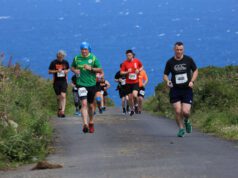overtraining/physiological testing Overtraining / underperformance syndrome, and physiological testing
As we are approaching the sharp end of the trrack season, with a few weeks to go for the National Championship, this is the time to realise your training programme to ensure that you do not suffer Overtraining/underperformance syndrome. My own views on Overtraining/underperformance would be that the syndrome should be seen as an overuse injury but a bit more complex. The reason I place it as an overuse injury is that 1. the amount of training overload is far beyond the body’s ability to recover, this doesn’t mean the repetitive training done over time, it also includes too sudden changes to the training programme. 2. The effects of overtraining/underperformance doesnt suddenly happen, it is a slow, oncoming process, such as the gradual feeling of unease, heaviness of the legs, struggling in warm up, loss of apetite. and, 3. The fact that the level of performance has dropped. So you treat overtraining/underperformance as if you are injured.
Now overtraining/underperformance has absolutely nothing to do with motivation, but has to do with the psychological processes going on, therefore a POMS assessment would indicate the level of stress – the POMS should be done on a continuous basis in order to identify when the athlete is starting to get to that state. But, if an athlete is presented with a severe inverse gradient the severity of the gradient indicates the amount of time for adequate recovery. Rest, alternative light exercise, and hydration are the only effective methods for treatment. It is best however to identify the symptoms of overtraining/underperformance and to ensure that there is an intervention strategy just in case.
As for physiological testing, physiology of the human body and training. Since the early 1990s heart rate monitoring has taken hold in middle-distance training in Europe and America, and like physiological testing on the treadmill, the level of performance declined. The problem with heart rate monitoring is that the heart only responds to the physical stress placed on the body – i.e. the demand for oxygen in the muslce cells. Therefore it would be like putting the cart before the horse and wondering why its not moving. If we take for example some concepts that affect human behaviour – such as stress, anxiety, excitement, fear etc., the physiological response to the body is the same, your heart rate increases, adrenalin is released, and the body prepares for fight or flight. These physiological responses are the same whether you want to ask someone of the opposite sex out on a date but are nervous, or you see a vicious dog coming after you. Monitoring you heart on a slow, easy recovery run can be very much counter-productive, especially when going over a multi-terrain course.
The best use of heart rate monitor is in the morning to check your resting heart rate, this can be used to evaluate whether you are over-training or coming down with a cold or flu. My own personal view is on easy, recovery days – run where you can have your heart rate as high as possible (threshold level) but having the body move at a rate where little or no stress is on the body (joggin) this provides a training effect, and the best way to do this is to find a very steep hill. I suggest having a look at Dr. Rosa’s Kenyan marathon training pyramid and you will see what I mean here. Ask any "Western – European, American" distance runner for their physiological stats and you would most likely get a response such as VO2Max, OBLA, Biomechanics, ask the same question to an Ethiopian, Kenyan, Moroccan and the answer would not be so forthcoming. Its not that the Africans do not know about Physiological testing – its just that it is not important to them in terms of how fast they can run. We can obssess about VO2, OBLA having specially designed orthotics and footwear, but athletes are getting distracted by them. High Performance Units at various places are offering full physiological testing, but such distractions a giving athletes a false sense of ability whereas a performance related competition or a time trial would provide a better level of understanding. In 1984 prior to the LA Games an unsure Steve Cram pulled together some of the North-East top athletes and ran a 1500m time trial on a rainy, blustery day in Gateshead. Satisfied with the time trial Cram finished 2nd in the 1500m final. Mike Mcleod who assisted Cram in the time trial won the silver in the 10,000m. The best indication of performance is performance itself, the next best indication are time trials, physiological testing only provide physiological markers and nothing else.
As we are approaching the sharp end of the trrack season, with a few weeks to go for the National Championship, this is the time to realise your training programme to ensure that you do not suffer Overtraining/underperformance syndrome. My own views on Overtraining/underperformance would be that the syndrome should be seen as an overuse injury but a bit more complex. The reason I place it as an overuse injury is that 1. the amount of training overload is far beyond the body’s ability to recover, this doesn’t mean the repetitive training done over time, it also includes too sudden changes to the training programme. 2. The effects of overtraining/underperformance doesnt suddenly happen, it is a slow, oncoming process, such as the gradual feeling of unease, heaviness of the legs, struggling in warm up, loss of apetite. and, 3. The fact that the level of performance has dropped. So you treat overtraining/underperformance as if you are injured.
Now overtraining/underperformance has absolutely nothing to do with motivation, but has to do with the psychological processes going on, therefore a POMS assessment would indicate the level of stress – the POMS should be done on a continuous basis in order to identify when the athlete is starting to get to that state. But, if an athlete is presented with a severe inverse gradient the severity of the gradient indicates the amount of time for adequate recovery. Rest, alternative light exercise, and hydration are the only effective methods for treatment. It is best however to identify the symptoms of overtraining/underperformance and to ensure that there is an intervention strategy just in case.
As for physiological testing, physiology of the human body and training. Since the early 1990s heart rate monitoring has taken hold in middle-distance training in Europe and America, and like physiological testing on the treadmill, the level of performance declined. The problem with heart rate monitoring is that the heart only responds to the physical stress placed on the body – i.e. the demand for oxygen in the muslce cells. Therefore it would be like putting the cart before the horse and wondering why its not moving. If we take for example some concepts that affect human behaviour – such as stress, anxiety, excitement, fear etc., the physiological response to the body is the same, your heart rate increases, adrenalin is released, and the body prepares for fight or flight. These physiological responses are the same whether you want to ask someone of the opposite sex out on a date but are nervous, or you see a vicious dog coming after you. Monitoring you heart on a slow, easy recovery run can be very much counter-productive, especially when going over a multi-terrain course.
The best use of heart rate monitor is in the morning to check your resting heart rate, this can be used to evaluate whether you are over-training or coming down with a cold or flu. My own personal view is on easy, recovery days – run where you can have your heart rate as high as possible (threshold level) but having the body move at a rate where little or no stress is on the body (joggin) this provides a training effect, and the best way to do this is to find a very steep hill. I suggest having a look at Dr. Rosa’s Kenyan marathon training pyramid and you will see what I mean here. Ask any "Western – European, American" distance runner for their physiological stats and you would most likely get a response such as VO2Max, OBLA, Biomechanics, ask the same question to an Ethiopian, Kenyan, Moroccan and the answer would not be so forthcoming. Its not that the Africans do not know about Physiological testing – its just that it is not important to them in terms of how fast they can run. We can obssess about VO2, OBLA having specially designed orthotics and footwear, but athletes are getting distracted by them. High Performance Units at various places are offering full physiological testing, but such distractions a giving athletes a false sense of ability whereas a performance related competition or a time trial would provide a better level of understanding. In 1984 prior to the LA Games an unsure Steve Cram pulled together some of the North-East top athletes and ran a 1500m time trial on a rainy, blustery day in Gateshead. Satisfied with the time trial Cram finished 2nd in the 1500m final. Mike Mcleod who assisted Cram in the time trial won the silver in the 10,000m. The best indication of performance is performance itself, the next best indication are time trials, physiological testing only provide physiological markers and nothing else.






